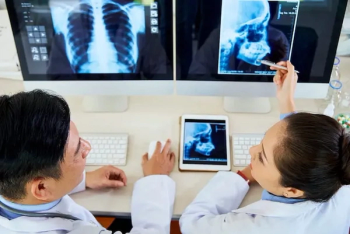
MR colonography proves effective but unpleasant
Although MR colonography is proving to be an effective method of colorectal screening, patients are no more likely to accept it than optical colonoscopy. In addition, limited bowel prep protocols for CT colonography are proving comparable to full cathartic prep.
Although MR colonography is proving to be an effective method of colorectal screening, patients are no more likely to accept it than optical colonoscopy. In addition, limited bowel prep protocols for CT colonography are proving comparable to full cathartic prep.
Dr. Aoife Keeling, a radiology fellow at Beth Israel Deaconess Medical Center, and colleagues compared the efficacy of MRC using air as an intraluminal contrast agent with optical colonoscopy in 46 patients. MRC identified lesions greater than 10 mm with 100% sensitivity and specificity. For intermediate and small lesions, sensitivity dropped to 50% and 15%, respectively, while specificity remained high.
While these results indicate that the technology is effective, other results revealed that patients are just as resistant to MRC as they are to optical colonoscopy. Keeling found that 35% preferred MRC over optical colonoscopy, 33% preferred colonoscopy to MRC, and 32% had no preference. Patients reported slightly more discomfort with MRC but more embarrassment with optical colonoscopy.
Dr. Sonja Kinner, a radiologist at University Hospital Essen in Germany, and colleagues found similar results in their study of patient acceptance of MRC versus optical colonoscopy. Researchers analyzed questionnaires submitted by 284 patients. MRC patients underwent fecal tagging procedures, while colonoscopy patients underwent full cathartic bowel preparations, as well as receiving sedatives and analgesics prior to colonoscopy. Investigators found no significant difference between the overall rating for the two procedures.
Patients rated ingestion of the electrolyte solution more unpleasant compared with ingestion of the tagging agent for MRC, while placement of the rectal tube and administration of water enema were rated the most unpleasant components of MRC. Patients showed no significant difference concerning preferences for future examinations: 46% indicated they would prefer MRC, while 43% voted for colonoscopy.
The prospect of conventional bowel preparation often discourages patients from undergoing colorectal cancer screening. Removing that obstacle may improve compliance with screening guidelines, according to Dr. C. Daniel Johnson, a radiologist at the Mayo Clinic in Rochester, MN.
Johnson and colleagues compared CT colonography and optical colonoscopy exams performed on patients with known or suspected colorectal polyps. Patients were administered barium with meals for two days before the CTC but did not face any dietary restrictions or cathartic bowel preparations. Optical colonoscopy found 87 adenomatous polyps of at least 1 cm in 68 patients. For the three readers using a primary 2D approach, sensitivity ranged from 81% to 89%, while specificity ranged from 88% to 100%.
Dr. Sebastiaan Jensch, a radiologist at the Academic Medical Center in Amsterdam, and colleagues used a similar noncathartic bowel preparation protocol for 174 patients at increased risk for colorectal cancer. Using a primary 2D approach, two readers and consensus found satisfactory sensitivity and high specificity for the protocol. Sensitivity was 76%, 87% and 82% for small, intermediate, and large polyps. Specificity was 79%, 94%, and 97%, respectively.
"This is comparable to studies reported in the medical literature with an extensive bowel preparation that were performed in comparable study groups at increased risk for colorectal cancer," Jensch said.
The sensitivity in Johnson's study was higher possibly because of a higher prevalence of disease in that symptomatic population, he said.
Jensch said the high false-positive rate in his study (42, 13, and six lesions stratified for size: small, intermediate, and large) was mostly caused by reader inexperience. Reader one trained on 50 cases, while reader two trained on 100.
"Insecure readers tend to have a lower threshold to mark a finding as a potential polyp. We strongly believe that with more reader experience the false-positive rate will decrease substantially," he said.
Additionally, he noted that the readers were satisfied with image quality, having excluded only four of 174 patients because of poor bowel preparation. He concluded that the tagging protocol was not the cause of the relatively high false-positive rate.
Newsletter
Stay at the forefront of radiology with the Diagnostic Imaging newsletter, delivering the latest news, clinical insights, and imaging advancements for today’s radiologists.




